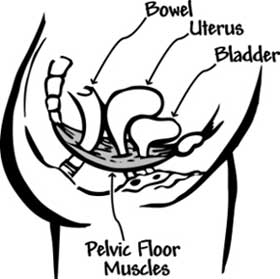
Prolapse after childbirth is a confronting and challenging problem for new mums. Women of childbearing age are usually shocked to learn of their prolapse after birth and often express surprise upon learning that vaginal delivery is a major risk factor for prolapse. Prolapse management places an added burden on new mothers, often at a time when they are dealing with the physical and emotional demands of motherhood.
Read on now for Pelvic Floor Physiotherapist information on:
- What is prolapse after childbirth?
- What causes prolapse after pregnancy and birth?
- What are the common prolapse symptoms after childbirth?
- How to manage and treat prolapse after childbirth
- Future pregnancy after prolapse diagnosis
Prolapse Exercises e-Book
International best selling prolapse exercise guide for women with prolapse and after prolapse surgery.
Prolapse Exercises teaches you how to:
- Exercise safely after prolapse surgery
- Reduce your risk or repeat prolapse
- Avoid unsafe exercises
- Choose pelvic floor safe exercises
- Reduce your risk of prolapse worsening
- Improve prolapse support
- Increase your strength and fitness
- Strengthen your core
- Lose weight
What is Prolapse after Childbirth?
Prolapse occurs when there is a weakness in the pelvic floor supporting structures. This weakness allows one or more of the pelvic organs (bladder, uterus and/or bowel) to move down into the walls of the vagina. The pelvic floor is usually weak after pregnancy and childbirth which means that with pelvic floor recovery, prolapse immediately after childbirth often improves from its initial presentation. Prolapse that resolves immediately after childbirth can still be an indication that future prolapse problems may arise.
Types of prolapse after childbirth include: 
Uterine prolapse –uterine prolapse involves prolapse of the cervix and uterus down into the vagina
Bladder prolapse (cystocoele) -involves a prolapsed bladder into the front wall of the vagina
Bowel prolapse (rectocoele) into the back wall of the vagina
These types of prolapse can exist alone or in combination with another prolapse for example uterine and bladder prolapse may coexist.
What Causes Prolapse after Pregnancy and Birth?
Pregnancy can contribute to the development of prolapse. During pregnancy the associated hormonal changes soften the supporting structures in the pelvic floor making them more elastic. This combined with the weight of the baby can stretch and strain the pelvic floor muscles and supporting tissues allowing the pelvic organs to move from the normal resting position.
Vaginal delivery can also contribute to pelvic prolapse. During delivery the pelvic floor muscles and tissues become stretched and strained, sometimes beyond their normal limits. Overstretching can lead to scar tissue formation as well as nerve damage within the pelvic floor. As a result the pelvic floor muscles can be damaged and weakened along with the strong tissues that hold the pelvic organs in place allowing them to move out of place and downwards into the vaginal walls.
Factors that increase the likelihood of pelvic floor damage with pregnancy and childbirth include:
- Traumatic delivery
- Large birth weight baby
- Pelvic floor muscle weakness
- Chronic constipation and straining
- Chronic chest problems causing coughing
- Multiparity (more than 1 baby however the risk slows after 2 deliveries)
- Obesity and overweight
What are the Symptoms of Prolapse after Childbirth?
Prolapse can present with or without symptoms after childbirth. When prolapse does present with symptoms these can include any of the following:
- Bulging sensation in the vagina
- Dragging heavy feeling in the pelvis
- Lower abdominal or lower back ache
- Visible bulge from the vagina
- Difficulty inserting or retaining tampons
Prolapse symptoms typically become more evident with prolonged standing or towards the end of the day.
How to Treat and Manage Prolapse after Childbirth
Immediate management of the pelvic floor after vaginal delivery is very similar to the way you would treat any other sprain in the body with Rest, Ice, Compression and Elevation or RICE.
- Rest – means avoiding prolonged standing or sitting upright on the swollen perineum in the early days following vaginal delivery
- Ice – is a valuable treatment for reducing swelling to promote healing. Ice can be used in the form of small cold pack (condoms can be filled with water and frozen). The ice is not applied directly to the skin; it is wrapped in cloth or paper towel and applied to the outside of the vagina for 10-20 minutes at a time. Ice can be repeated at intervals throughout the day for as long as swelling persists. Dry the perineum by gently patting the area immediately after ice to avoid wetness especially over stiches.
- Compression – can be provided with supportive underwear to help to hold the ice pack in place.
- Elevation – is useful to reduce swelling and alleviate vaginal discomfort. Laying down flat with a pillow under the knees is an excellent position to rest, relieve vaginal discomfort and apply ice.
Pelvic Floor Exercises
Pelvic floor exercises (Kegels) are very important in promoting pelvic floor recovery after childbirth. Pelvic floor exercises are also known to reduce prolapse symptoms in mild to moderate prolapse. Pelvic exercises also lift the pelvic floor muscles (and prolapse) to sit higher within the pelvis. If you have been diagnosed with a prolapse after childbirth pelvic floor exercises can be commenced with your obstetrician’s approval. Most women can recommence these exercises in the early days following delivery however in the case of tearing and extensive stitching women can be advised to wait for healing before starting.
The Knack is an excellent technique to use to protect the pelvic floor and prolapse after childbirth. This technique which involves a strong lift and squeeze of the pelvic floor muscles before and during increases in downward pressure on the pelvic floor (e.g. cough, sneeze). The Knack may prevent further downward stretch and strain on the pelvic floor.
Rest
It is vital for new mums to take time to rest to promote pelvic floor recovery especially if they are suffering from prolapse symptoms. During the course of the day the upright work of standing, lifting and caring for one or more children increases the load on the pelvic floor. Towards the end of the day prolapse symptoms may be more pronounced as a direct result. Resting with the feet elevated at intervals throughout the day combined with a program of regular pelvic floor exercise will promote overall recovery of the pelvic floor.
Pessaries
Support pessary devices can be a valuable prolapse management and treatment strategy for new mothers, especially those seeking to wait for natural recovery and those women who would like to have not yet completed their families.
Support pessaries are available in a wide range of designs and sizes. The pessary device sits high within the vagina and lifts the prolapsed tissued. A well fitting pessary can allow the new mum to better manage the physical demands of caring for her baby. There is also some suggestion pelvic floor exercises may be more effective by lifting the prolapsed tissues within the vagina.
Bowel Management
Avoiding straining and constipation is an important part of prolapse management. Bowel management involves appropriate diet to promote good stool consistency and avoid constipation. Bowel emptying and prolapse protection can be promoted by using the correct position and technique for bowel emptying to avoid straining the pelvic floor.
Chest Management
In women suffering from chronic chest conditions, prolapse management also involves appropriate management. If you suffer from a chronic chest condition (e.g. asthma, chronic bronchitis) and have a prolapse, ensure that you have a good management program in place to reduce or minimise the effect of exacerbations, particularly those that cause you to cough.
Pelvic Floor Safe Exercise
Pelvic floor safe exercise is vital for new mums seeking to get back into shape. After pregnancy and childbirth women are at increased of pelvic floor injury with inappropriate exercises that overload the pelvic floor because their pelvic floor muscles are often weak and not working to support the pelvic organs as well as prior to pregnancy.
Pelvic floor safe exercises for new mums involve low impact general fitness exercises (e.g. walking, stationary cycling), appropriate core abdominal exercises and pelvic floor safe strength training exercises. New mums, particularly those with prolapse problems will benefit from avoiding high impact exercises, intense core abdominal exercises and heavy weight-loaded strength routines to avoid worsening of their prolapse.
Future Pregnancy after Prolapse Diagnosis
One of the major concerns some women face is concern about whether they can have more children with a prolapse. Having a prolapse does not affect a woman’s fertility or her ability to fall pregnant again. The ease of pregnancy will depend upon the severity of prolapse. Many women with prolapse go on to have more children without difficulty. Some women with prolapse issues find that subsequent pregnancies are more uncomfortable owing to vaginal heaviness and dragging during the pregnancy. If you have a prolapse and would like to have more children it is advisable to discuss this with your medical caregiver who can provide you with specific information based upon his/her assessment of your prolapse and medical history.
Prolapse after childbirth is indeed a challenging and sometimes overwhelming problem for the new mum. Prolapse after pregnancy and birth can be well managed and pelvic floor recovery promoted with appropriate exercises, rest and attention to those additional preventative factors that will help to protect the pelvic floor from further injury.







